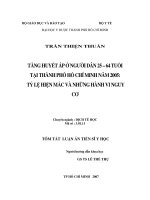Cầu cơ động mạch vành tỷ lệ hiện mắc, đặc điểm lâm sàng và cận lâm sàng ở người việt nam
Bạn đang xem bản rút gọn của tài liệu. Xem và tải ngay bản đầy đủ của tài liệu tại đây (1.67 MB, 19 trang )
Prevalence and characteristics of myocardial
bridge in patients undergoing percutaneous
coronary angiography
BS Nguyễn Văn Tuấn - BVQY 103
INTRODUCTION
Myocardial bridge (MB): a muscle bridge over a segment of
the coronary arteries that leads to narrowing of coronary artery
Systolic
Diastolic
INTRODUCTION
Prevalence:
• Autopsy: 5,4% ~ 85,7%*
• Angiography: 0,5% ~ 16%
Clinical significance:
* Jorge R. Alegria (2005): Myocardial bridging, European Heart Journal 26, 1159-1168.
INTRODUCTION
INTRODUCTION
INTRODUCTION
Treatment of symptomatic patients:
• Negative inotropic and/or negative chronotropic agents: Betablocker, calcium antagonists.
OBJECTIVE
To investigate the prevalence, clinical and
paraclinical characteristics of myocardial bridge
in patients undergoing PCA
SUBJECTS AND METHODS
SUBJECTS
1386 patients underwent PCA in Department of
Cardiology, Military Hospital 103 from 1/2013 to 3/2016
METHODS
• Descriptive, cross – sectional.
• Clinical and paraclinical examination
• Percutaneous coronary angiography (PCA)
SUBJECTS AND METHODS
• Diagnosis of MB: Systolic compression of the artery
with narrowing of the lumen and diastolic relaxation.
• Grading of angina pectoris: Canadian Cardiovascular
Society (CCS) (1976)
• Assessment of coronary artery stenosis *
Mild: < 50%
Moderate: 50 – 74%
Severe: ≥ 75%
*Kern MJ (2013), “The interventional cardiac catheterization handbook third edition”.
RESULTS
Chart 1. Myocardial bridge prevalence
1291 pts
(93.2%)
no MB
MB
95 pts (6.8%)
. John R. Kramer (1982): 12% (PCA)
. Atar E (2007): 17% (MSCT)
. Lazoura O (2010): 21% (MSCT)
RESULTS
Table 1. General characteristic of participants (n = 95)
Variable
X ± SD or n (%)
Age (year)
61.85 ± 12.45
Male
77 (81.1%)
Concomitant
diseases
Hypertension
55 (57.9%)
Type 2 Diabetes
Mellitus
13 (13.7%)
Stable ischemic
heart disease
14 (14.73%)
RESULTS
Table 2. Grading of angina pectoris according to CCS (n = 81)
CCS
n (%)
1
35 (43.2%)
2
30 (37%)
3
15 (18.6%)
4
1 (1.2%)
Total
81 (100%)
RESULTS
Table 3. ECG characteristic (n = 81)
Variable
ECG
X ± SD or n (%)
Normal
61 (75.3%)
ST depression, T (-)
12 (14.8%)
ST elevation
8 (9.9%)
Li Wan (2005): Abnormal ECG occurred in 10% patients.
RESULTS
Table 4. Echocardiography characteristic (n = 81)
X ± SD or n (%)
Variable
Echocardiography
LVDd (mm)
46.74 ± 5.98
LVDs (mm)
29.95 ± 6.38
EF (%)
63.76 ± 10.50
Regional wall dyskinesia
6 (7.4%)
LV dilatation
17 (20.9%)
RESULTS
Chart 2. MB locations (n = 81)
1.20%
2.40%
LAD1
LAD2
LAD3
LCX
RCA
OTHERS
2.40% 3.60%
30.10%
Atar E (2007): 60% MB in LAD
Lazoura O (2010): 100% MB in LAD, 68% in LAD2
60.30%
RESULTS
Table 5. The degree of systolic coronary stenosis caused by MB (n = 81)
Degree
n (%)
Mild (< 50%)
52 (64.19%)
Moderate (50-74%)
20 (24.69%)
Severe
Total
75-89%
4 (4.95%)
≥ 90%
5 (6.17%)
81 (100%)
RESULTS
Table 6. The relation between angina and coronary artery stenosis degree
(n = 81)
CCS 1-2
Mild and
Moderate
stenosis (n(%))
Severe stenosis
(n(%))
58 (71.6%)
7 (8.6%)
p
> 0.05
CCS 3-4
14 (17.3%)
2 (2.5%)
CONCLUSION
The prevalence of MB is 6.8% of patients
undergoing percutaneous coronary angiography.
Most of MB was found in LAD
There was no relation between angina and
coronary artery stenosis degree









